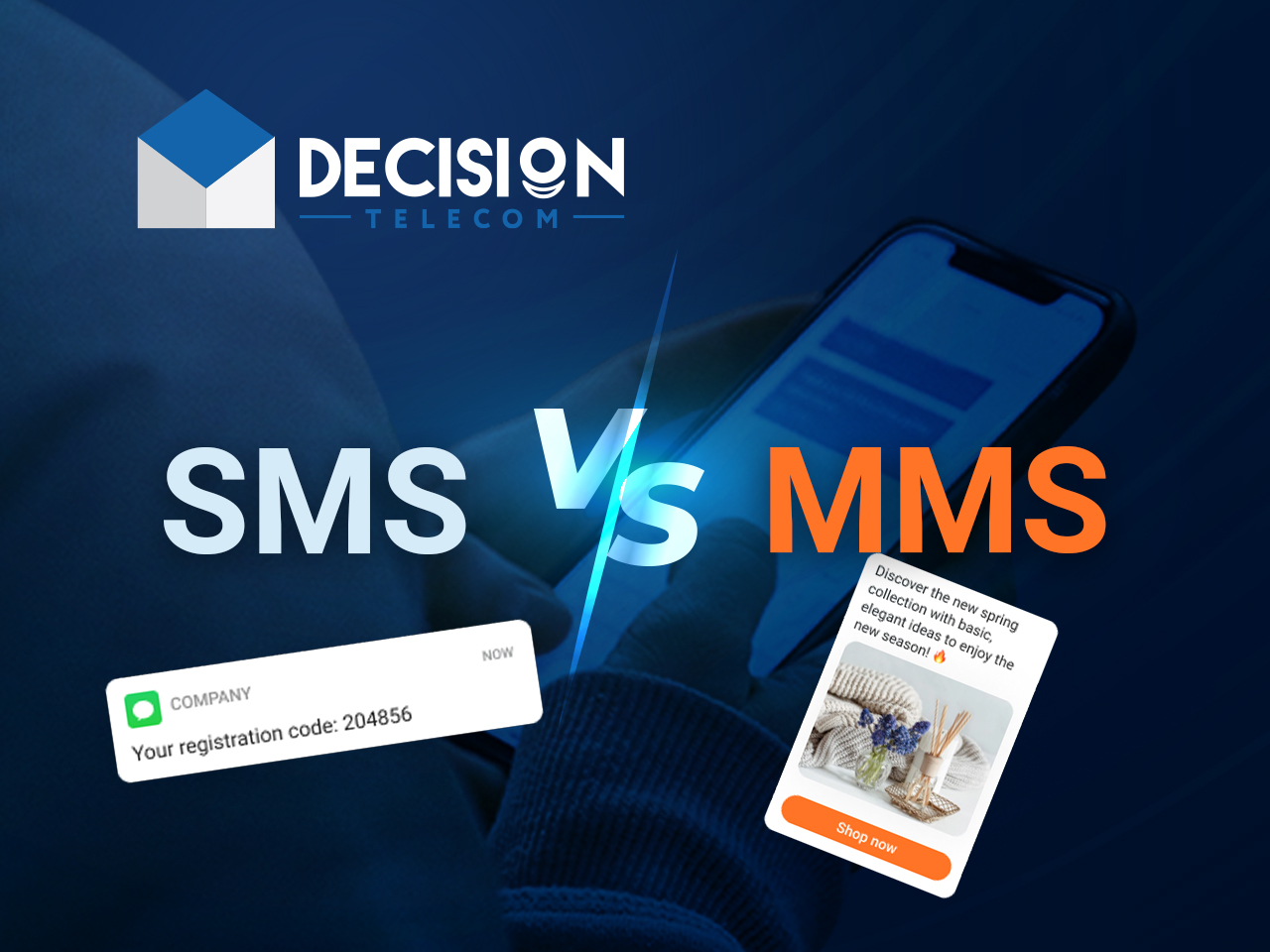
SMS vs MMS: Key Differences and Importance in the Modern Day
https://decisiontele.com/news/promotional-texts.htmlSMS and MMS are the two most common messaging methods. However, while SMS remains the preferred mode of communication year after year, MMS messages are becoming a thing of the past. Why? Let's figure it out.
But first, we elaborate on how these well-known MMS and SMS messages are defined, how they work, and the differences between them.
What is SMS?
SMS stands for Short Message Service, an in-built text messaging feature packaged into even the most basic type of cellular phone. It usually supports a plethora of languages at a global level, with a 160-character limit, typically.
Hand-held mobile devices, during the late 90s to early 2000s, introduced expressive ASCII faces and emoticons as an added bonus alongside the basic alphanumerical format. Soon "texting" became one of the most popular means of communication for people on the go.
What is MMS?
MMS stands for Multimedia Messaging Service. It was first popularised in the early 2000s, allowing people to attach images and videos to their texts, which explains its name. Not just graphics, MMS messages also allow other file types such as audio and documents. They offer a more flexible character limit to users.
SMS vs MMS: 4 key differences
SMS is a standard protocol for sending and receiving text messages to a mobile device. MMS is an evolution of SMS, providing the ability to send more varied multimedia messages. Let's look at four key comparisons of SMS vs MMS.
Number of characters
SMS texts are limited by their character count, which is usually up to 160 per text for messages that use standard GSM encoding. If the message happens to exceed the designated character limit, it may be split into multiple SMS messages. And if the length gets too long (sometimes due to the use of special characters that take up the space of multiple characters each), some devices and apps also automatically prompt the user to seek permission to send the SMS as an MMS instead.
As for MMS messages, instead of the number of characters, the length of a message is based more on the size of the attachments and the allowed data limits of the texting service or SMS provider the sender uses. Generally, an MMS message is not bound by the strict 160-character limit that the SMS message is.
Supported content
Texting via SMS limits the user to only include simple alphanumeric and special characters, making it similar to a handwritten letter with no embellishments, typed out and sent via the cellular network. The maximum you can do is use symbols like : ) ; [ and others to make plaintext emojis.
Comparatively, MMS allows the user to add in images, audio messages, voice notes, videos – even photos you may have taken with that same mobile phone camera. It allows a more interactive design with more room for creativity.
Sending method
SMS messaging is simple – the format and layout are clean, and the message size is small. The text is sent using the SS7 (Signaling System No. 7) standard, which delivers the simple lines of text straight to the recipient's device with no special requirements or distractions. There is no need for an internet connection. The sender and recipient both only need a mobile network connection.
MMS messages, with their small attached files, are sent via the internet, usually via the Wireless Application Protocol (WAP). This doesn’t mean you need wifi! You would still need to be on the cell network, except you would have to use your mobile data (aka mobile internet connection) for sending the MMS.
Deliverability and pricing
SMS messages, with their cost-effectiveness, conciseness, and, subsequently, small message size, make it quite easy to deliver. On top of that, the fact that they only utilize the mobile network for transmission makes SMS delivery rates even better. The SMS lands into the recipient’s inbox almost instantly (unless you’re in an area with poor cell reception!).
Typically, cell network providers offer SMS messaging for quite affordable rates, with many of them including a set number of SMSes for free with the usual phone plans.
MMS messaging can be a bit less reliable in terms of delivery surety due to the larger message sizes as well as the fact that it needs a stable connection. Multimedia messages require higher bandwidth, too, along with proper support from the network and the recipient's device. Because of this, there is a risk of delay or non-delivery of the MMS.
Mobile network services often charge 2-3 times the fee they charge for an SMS. You’re charged for each type of file – be it audio, video, or image – depending on the size of the attachment.
The pros and cons of SMS and MMS messages
Both SMS and MMS have their own benefits and disadvantages.
SMS messages are usually transmitted more quickly compared to MMS since they are minimal in size. For MMS messages in marketing, the speed can be slower due to the size of the attachments included, reception quality, and network capabilities. Any hindrance to any of these factors could marginally impede and delay the recipient.
Compared to MMS, SMS does not allow its users to explore the possibilities of multimedia content. It also limits the amount of content you can include in each message, forcing the sender to keep things short. It might make messages seem direct and boring, sometimes bordering on rude, if you don’t include any emojis either. If want to use an SMS service for marketing purposes, it can be tricky to make an SMS text message sound creative.
Due to the significantly lower pricing offered by most network service providers, SMS is preferred by the general demographic more often than MMS is.
Why is MMS no longer relevant?
Despite the flexibility it offers in terms of the transmission of multimedia content, MMS have lost their relevance for various reasons.
-
They are sometimes incompatible with certain mobile devices and operating systems, which can cause major breakdowns in communication. This is even worse if the sender has no way of knowing that the recipient's device can't receive MMS messages. This is an automatic limiter to their dependability.
-
Modern telecom operators may limit or disable MMS support.
-
With the advent of WhatsApp, Telegram, Facebook Messenger, Snapchat, and other instant messengers, users no longer need MMS to send multimedia content without restrictions.
What to choose between SMS vs MMS
Despite the apparent improvement that MMS offers over SMS, the latter cannot be replaced, as is evident by our ever-growing texting culture and the promotion of businesses via SMS marketing today. SMS is cheaper, with almost instant delivery and greater reliability, making it ideal for sending short text messages, largely compatible with various devices and networks.
We at Decision Telecom understand the importance of effective business communication. That's why we offer a customer engagement platform that supports SMS as well as other necessary channels.
With our platform, you can easily create and send engaging and effective messages to your customers, regardless of their location and type of mobile device.


